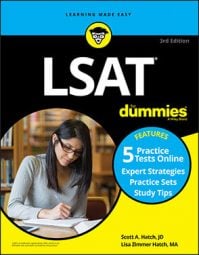You will encounter ordering questions on the LSAT/ When you’ve assembled your game board to the best of your abilities and within a reasonable time frame (about four to five minutes), you’re ready to tackle the set of five to eight questions that follow the ordering game’s facts and rules.
Substitute condition questions
Since 2009, a new question type has cropped up in the analytical reasoning section of the LSAT. It asks you to choose a condition in the answer choices that could replace one of the original conditions without changing anything about the orders. This new twist on analyzing conditions appears in some grouping games, but it’s more common in ordering games.
It’s unlikely to appear more than once on your LSAT, and it’s often the last question in the set, which is great because by the last question, you’ve established several possible orderings to draw from. Here’s an example:
A circus performer includes exactly six activities in an act — bungee jumping, flame throwing, juggling, lion taming, sword swallowing, and trapeze swinging. The performer carries out each activity one at a time and no more than once during the act. The order in which the performer carries out the activities is subject to the following conditions:
Lion taming occurs before bungee jumping.
Flame throwing occurs immediately before bungee jumping.
Trapeze swinging occurs before sword swallowing.
Trapeze swinging occurs either immediately before or immediately after juggling.
Which one of the following, if substituted for the condition that trapeze swinging occurs before sword swallowing, would have the same effect on determining the order of the performer’s act?
(A)Sword swallowing occurs before juggling.
(B)Sword swallowing occurs before flame throwing.
(C)Juggling occurs before sword swallowing.
(D)Sword swallowing occurs either immediately before or immediately after juggling.
(E)Sword swallowing may not occur first, second, or third.
To answer this question, create a game board:
List the game pieces: B, F, J, L, S, and T.
Create a box chart with six columns numbered 1 through 6.
Record the first rule: L → B.
Record the second rule: FB.
Record the third rule: T → S.
Record the fourth rule: TJ or JT.
Extend the board by entering on the chart where pieces don’t fit and by combining rules, such as L → FB and TJ/JT → S.
Consider possible orderings.
The board looks something like this:
Here are the steps to answering questions that ask for a substitute condition:
Determine what effect the original condition has on the board.
It places T before S.
Check the answers to see which one would place T before S in all orderings.
Eliminate answers that don’t jibe with your game board.
Choice (E) has to be wrong because S can be third in some orderings. Choice (A) puts S before T in all orderings, so it’s out.
Rule out answers that don’t have the same effect on the orderings as the original.
Choice (B) affects the order of S and F, but it doesn’t put T before S in all orderings. You could have LSFBTJ, which doesn’t maintain the third condition that T occurs before S. Choice (D) swaps S for T, which doesn’t ensure that T occurs before S in all orderings.
Check the remaining answers to determine whether they affect the orders in the same way.
Choice (C) looks promising. Notice that whatever holds true for T is also true for J. The two acts, which are always consecutive, may hold the same positions, regardless of the orderings.
Therefore, Choice (C) provides the same condition as the one that requires T to occur before S. T is interchangeable with J, so pick the answer that exchanges T for J in the original third condition. Choice (C) is correct.
Completely determined order questions
Another, even less common question is one that asks you to choose the condition that would allow you to create an exact ordering of the pieces. This question type may appear in an ordering set. The ordering game’s conditions narrowed the possible orderings to these:
And you may be asked this question:
The order in which the orchestra plays the musical pieces at the holiday concert is completely determined if which one of the following is true?
(A)The polka is played second.
(B)The concerto is played first.
(C)The march is played last.
(D)The waltz is played fourth.
(E)The sonata is played last.
Attack this question methodically:
Eliminate obviously incorrect answers.
Choice (E) can’t be right. The orchestra never plays the sonata last. Also notice that P can never be second, so Choice (A) is wrong. If P were second, C would have to be first, but that would put C before A and P before W, which violates the condition that A is before C when P is before W.
Dismiss conditions that could apply to more than one possible order.
Many of the possible orders have C in the first spot and M last, so Choices (B) and (C) are incorrect.
Check the remaining answer.
The last order on the chart is the only one with W in the fourth spot. When the waltz is fourth, all the other pieces fall into place. The four spots after W have to be filled by S, R, T, and M, so P and A have to join C in the first three spots. P comes before W, and when P is before W, A is before C.
So A has to be first and C second. With C second, S has to be sixth, and R, T, and M fit into the fifth, seventh, and eighth spots, respectively, to retain their relative order. Choice (D) is the answer.

